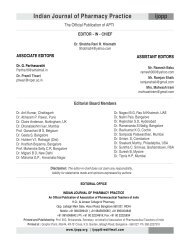Oct-Dec, 2011 - Indian Journal of Pharmacy Practice
Oct-Dec, 2011 - Indian Journal of Pharmacy Practice
Oct-Dec, 2011 - Indian Journal of Pharmacy Practice
- No tags were found...
Create successful ePaper yourself
Turn your PDF publications into a flip-book with our unique Google optimized e-Paper software.
Dinesh KU - Evaluation <strong>of</strong> the Impact <strong>of</strong> a Pharmaceutical Care Program for Diabetes Patients in Nepal: A Preliminary StudyOPERATIONAL MODALITY:Newly diagnosed diabetes patient who visited to medicinedepartment <strong>of</strong> the hospital during the study period wereenrolled in the study after getting their written consent. Total31 patients were enrolled in the study. They were divided intothree groups [control group (CG), test group-1 (TG-1) and testgroup-2 (TG-2)] on the basis <strong>of</strong> 1 to 1 enrollment method. Oneto one enrollment method is, the first patient who visited themedication counseling center was enrolled first in CGfollowed by TG-1 and TG-2. The patient demographic detailswere documented in socio-demography form. All three grouppatients were evaluated for KAP and satisfactionquestionnaire at the time <strong>of</strong> their enrollment (baseline) in thestudy.The patients enrolled in control group (CG) were kept onnormal care given by the doctor through out the study. Patientenrolled in test group-1 and test group-2 was providedpharmaceutical care. The patient enrolled in test group-1 (TG-1) were received the special counseling and education aboutdiabetes management, medication use, life style and dietarymodification and different exercises by providing themdietary chart, diabetes information booklet to make themunderstand about disease and medication calendar to increasethe patient compliance to the drugs. Patients <strong>of</strong> this groupwere also exposed to diabetes provided long termcomplication chart to aware about diabetes complication. TG-2 patient were provided all the information like TG-1 but theyalso received the extra demonstration <strong>of</strong> diabetes kit speciallymade for them. After the completion <strong>of</strong> two months from thedate <strong>of</strong> patient's enrollment, all the three groups wereevaluated for KAP and satisfaction level. The flow chart <strong>of</strong> thestudy is given in figure 1.All 31 patients enrolled in the study had undergone theirfasting blood sugar (FBS) and post prandial sugar (PPBS)check up at their first day visit (baseline) to hospital. Randomblood sugar (RBS) and glycated haemoglobin (HbA1c) wasnot taken into the consideration in the study because it was notdone uniformly in all patients. Same patients were againundergone their blood sugar check up after completion <strong>of</strong>their two months follow up.The total cost incurred by all three groups <strong>of</strong> patients fromtheir enrollment in the study till completion was alsocalculated. The direct cost analysis was done on the basis <strong>of</strong>different parameters like travel cost, food, hospitalregistration cost, hospitalization cost, investigation cost,medication cost. The cost calculation was done from patientperspective since the patient pay for it.Data analysis: The data collected was entered in SPSSversion16 and Micros<strong>of</strong>t excel sheet. The descriptive analysiswas done to analyze the parameter as per the objectives. Theimprovement in the KAP scores were compared usingWilcoxon signed rank test.Fig.1: The flow chart <strong>of</strong> operational modalitystPatient enrollment in study at their 1 day visit to hospital(n=31)(n=10)Control GroupBaseline(n=11)Test Group-1Baseline(n=10)Test Group-2BaselineDemography details and evaluation<strong>of</strong> KAP and satisfaction questionsDemography details and evaluation<strong>of</strong> KAP and satisfaction questionsDemography details and evaluation<strong>of</strong> KAP and satisfaction questionsNormal care with medicationduring study periodPharmaceutical care apart from normal care likei. more emphasize on education and counselingabout diabetes and importance <strong>of</strong> medication usedii.Provided diabetes booklet, diet chart, medicationcalendarPharmaceutical care likeTG-1 but also demonstration<strong>of</strong> diabetic kit through outstudy period for two monthsAfter completion <strong>of</strong> two monthsEvaluation <strong>of</strong> KAP and satisfactionby KAP and satisfaction questionsAfter completion <strong>of</strong> two monthsEvaluation <strong>of</strong> KAP and satisfactionby KAP and satisfaction questionsAfter completion <strong>of</strong> two monthsEvaluation <strong>of</strong> KAP and satisfactionby KAP and satisfaction questions<strong>Indian</strong> <strong>Journal</strong> <strong>of</strong> <strong>Pharmacy</strong> <strong>Practice</strong> Volume 4 Issue 4 <strong>Oct</strong> - <strong>Dec</strong>, <strong>2011</strong> 52
















